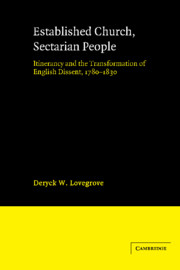 Established Church, Sectarian People
Established Church, Sectarian People Book contents
- Frontmatter
- Contents
- List of figures
- Preface
- Acknowledgements
- List of abbreviations
- 1 The Established Church and English Separatism
- 2 Itinerancy and Dissent
- 3 Preachers and sponsors
- 4 The academic leaven
- 5 Organization and infrastructure
- 6 Support and opposition
- 7 Criticism and legality
- 8 Developments and trends
- Conclusion
- Appendix A Journal of T[homas] Wastfield, June 1797–April 1798
- Appendix B Organizations active in itinerant evangelism
- Appendix C Baptismal statistics
- Notes
- Bibliography
- Index
5 - Organization and infrastructure
Published online by Cambridge University Press: 13 October 2009
- Frontmatter
- Contents
- List of figures
- Preface
- Acknowledgements
- List of abbreviations
- 1 The Established Church and English Separatism
- 2 Itinerancy and Dissent
- 3 Preachers and sponsors
- 4 The academic leaven
- 5 Organization and infrastructure
- 6 Support and opposition
- 7 Criticism and legality
- 8 Developments and trends
- Conclusion
- Appendix A Journal of T[homas] Wastfield, June 1797–April 1798
- Appendix B Organizations active in itinerant evangelism
- Appendix C Baptismal statistics
- Notes
- Bibliography
- Index
Summary
The adoption of a wider concept of ministry had raised few problems of principle for late eighteenth-century Dissenters, and this proved to be equally true of the working arrangements necessary for concerted itinerancy. By 1810 the principal features were well in evidence, their evolution being determined by the need to promote evangelism under varying circumstances and in the context of fluctuating and uncertain resources. Not every mode of operation proved in practice to be beneficial. Indeed there is ample evidence to suggest that whatever success was ultimately experienced was achieved in spite of certain inherent weaknesses.
For those engaging in evangelism the matter of organization was immediate and inescapable. Individual and collective effort could assume a spontaneous and unco-ordinated character of the type readily attributable to the unpredictable movement of the Holy Spirit, or it could submit to varying degrees of supervision designed to ensure that the energies available would be applied as effectively as possible to the opportunities presented by a given area. The formation of societies for the financial support of village preaching represented the first stage in this process, but as the records of a number of bodies show there was often an unwillingness to remain content with the mere material benefits of union. They display a determination to exploit more fully the newly discovered organizational potential.
In 1800 the recently formed Essex Congregational Union adopted a statistically based plan for the systematic evangelization of the entire county.
- Type
- Chapter
- Information
- Established Church, Sectarian PeopleItinerancy and the Transformation of English Dissent, 1780–1830, pp. 88 - 104Publisher: Cambridge University PressPrint publication year: 1988
